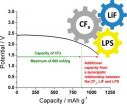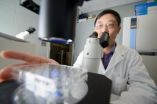(Press-News.org) LA JOLLA, CA— April 24, 2014 —A team led by scientists at The Scripps Research Institute (TSRI) working with the International AIDS Vaccine Initiative (IAVI) has discovered a new vulnerable site on the HIV virus. The newly identified site can be attacked by human antibodies in a way that neutralizes the infectivity of a wide variety of HIV strains.
"HIV has very few known sites of vulnerability, but in this work we've described a new one, and we expect it will be useful in developing a vaccine," said Dennis R. Burton, professor in TSRI's Department of Immunology and Microbial Science and scientific director of the IAVI Neutralizing Antibody Center (NAC) and of the National Institutes of Health's Center for HIV/AIDS Vaccine Immunology and Immunogen Discovery (CHAVI-ID) on TSRI's La Jolla campus.
"It's very exciting that we're still finding new vulnerable sites on this virus," said Ian A. Wilson, Hansen Professor of Structural Biology, chair of the Department of Integrative Structural and Computational Biology and member of the Skaggs Institute for Chemical Biology at TSRI and member of the NAC and CHAVI-ID.
The findings were reported in two papers—one led by Burton and the second led by TSRI Assistant Professor Andrew B. Ward, also a member of NAC and CHAVI-ID, and Wilson—appearing in the May issue of the journal Immunity.
The discovery is part of a large, IAVI- and NIH-sponsored effort to develop an effective vaccine against HIV. Such a vaccine would work by eliciting a strong and long-lasting immune response against vulnerable conserved sites on the virus—sites that don't vary much from strain to strain, and that, when grabbed by an antibody, leave the virus unable to infect cells.
Cloaked by Shields
HIV generally conceals these vulnerable conserved sites under a dense layer of difficult-to-grasp sugars and fast-mutating parts of the virus surface. Much of the antibody response to infection is directed against the fast-mutating parts and thus is only transiently effective.
Prior to the new findings, scientists had been able to identify only a few different sets of "broadly neutralizing" antibodies, capable of reaching four conserved vulnerable sites on the virus. All these sites are on HIV's only exposed surface antigen, the flower-like envelope (Env) protein (gp140) that sprouts from the viral membrane and is designed to grab and penetrate host cells.
The identification of the new vulnerable site on the virus began with tests of blood samples from IAVI Protocol G, in which IAVI and its NAC partnered with clinical research centers in Africa, India, Thailand, Australia, the United Kingdom and the United States to collect blood samples from more than 1,800 healthy, HIV-positive volunteers to look for rare, broadly neutralizing antibodies. The serum from a small set of the samples indeed turned out to block the infectivity, in test cells, of a wide range of HIV isolates, suggesting the presence of broadly neutralizing antibodies. In 2009, scientists from IAVI, TSRI and Theraclone Sciences succeeded in isolating and characterizing the first new broadly neutralizing antibodies to HIV seen in a decade.
Emilia Falkowska, a research associate in the Burton laboratory who was a key author of the first paper, and colleagues soon found a set of eight closely related antibodies that accounted for most of one of the sample's HIV neutralizing activity. The scientists determined that the two broadest neutralizers among these antibodies, PGT151 and PGT152, could block the infectivity of about two-thirds of a large panel of HIV strains found in patients worldwide.
Curiously, despite their broad neutralizing ability, these antibodies did not bind to any previously described vulnerable sites, or epitopes, on Env—and indeed failed to bind tightly anywhere on purified copies of gp120 or gp41, the two protein subunits of Env. Most previously described broadly neutralizing HIV antibodies bind to one or the other Env subunit. The researchers eventually determined, however, that PGT151 and PGT152 attach not just to gp120 or gp41 but to bits of both.
In fact, gp120 and gp41 assemble into an Env structure not as one gp120-gp41 combination but as three intertwined ones—a trimer, in biologists' parlance. PGT151 and 152 (which are nearly identical) turned out to have a binding site that occurs only on this mature and properly assembled Env trimer structure.
"These are the first HIV neutralizing antibodies we've found that unequivocally distinguish mature Env trimer from all other forms of Env," said Falkowska. "That's important because this is the form of Env that the virus uses to infect cells."
Structure Revealed
The second of the two new studies was an initial structural analysis of the new vulnerable epitope.
Using an integrative approach that combined electron microscopy on the Env trimer complex with PGT151 (led by the Ward lab) with the structure of the PGT151 Fab by x-ray crystallography (led by the Wilson lab), the scientists were able to visualize the location of the PGT151-series binding site on the Env trimer—which includes a spot on one gp41 protein with two associated sugars (glycans), a patch on the gp120 protein and even a piece of the adjacent gp41 within the trimer structure—"a very complex epitope," said Claudia Blattner, a research associate in the Wilson laboratory at TSRI and member of the IAVI Neutralizing Antibody Center who, along with graduate student Jeong Hyun Lee, was a first author of the second paper.
A surprise finding was that the PGT151-series antibodies bind to the Env trimer in a way that stabilizes its otherwise fragile structure. "Typically when you try to purify the native Env trimer, it falls apart, which has made it very hard to study," said Ward. "It was a key breakthrough to find an antibody that stabilizes it."
Although the PGT151 site is valuable in itself as an attack point for an HIV vaccine, its discovery also hints at the existence of other similar complex and vulnerable epitopes on HIV.
INFORMATION:
Authors and Funding
In addition to the scientists named above, the contributors to the first paper, "Broadly neutralizing HIV antibodies define a novel glycan-dependent epitope on the pre-fusion conformation of gp41 on cleaved Envelope trimers," were Alejandra Ramos, Jeong Hyun Lee, Chi-Hui Liang and Pascal Poignard, all from TSRI and IAVI Neutralizing Antibody Center; Alejandro Ramirez, Ryan McBride, Michael B. Zwick and James C. Paulson from TSRI; Katie J. Doores from King's College London School of Medicine; Ronald Derking, Marit J. van Gils and Rogier W. Sanders from the Academic Medical Center, Amsterdam; Sachin S. Shivatare, Chung-Yi Wu and Chi-Huey Wong of Academia Sinica, Taipei, Taiwan; Po-Ying Chan-Hui and Kristine Swiderek of Theraclone Sciences, Inc., Seattle; Yan Liu and Ten Feizi of Imperial College London; Michael S. Seaman of Beth Israel Deaconess Medical Center in Boston; John P. Moore of Weill Medical College of Cornell University; and Wayne C. Koff of IAVI in New York City.
The contributors to the second paper, "Structural delineation of a quaternary, cleavage-dependent epitope at the gp41-gp120 interface on intact HIV-1 Env trimers," included Kwinten Sliepen, Ronald Derking, Alba Torrents de la Peña, Marit van Gils and Rogier W. Sanders from the Academic Medical Center, Amsterdam; Albert Cupo and John P. Moore of Weill Medical College of Cornell University; Jean-Philippe Julien and Pascal Poignard of TSRI and IAVI Neutralizing Antibody Center; and Wenjie Peng and James C. Paulson of TSRI.
Funding for the first study came from IAVI; the National Institutes for Health (grant AI33232, HIVRAD P01 AI82362); the NIH-funded Center for HIV/AIDS Vaccine Immunology and Immunogen Discovery (CHAVI-ID) (grant UM1AI100663); The Ragon Institute of Massachusetts General Hospital, MIT and Harvard; and the Aids Fonds Netherlands (grants #2011032, #2012041).
Funding for the second study was provided by IAVI, CHAVI-ID (UM1 AI100663); NIH (P30AI036214, HIVRAD P01 AI082362 and R01 AI084817); the University of California, San Diego Center for AIDS Research; The California HIV/AIDS Research Program; Aids Fonds Netherlands (grant #2011032); the Netherlands Organization for Scientific Research; the European Research Council; and the German Academic Exchange Service.
IAVI's funding of this work arose in part from the United States Agency for International Development (USAID). USAID administers the foreign assistance program providing economic and humanitarian assistance in more than 120 countries worldwide.
About The Scripps Research Institute
The Scripps Research Institute (TSRI) is one of the world's largest independent, not-for-profit organizations focusing on research in the biomedical sciences. TSRI is internationally recognized for its contributions to science and health, including its role in laying the foundation for new treatments for cancer, rheumatoid arthritis, hemophilia, and other diseases. An institution that evolved from the Scripps Metabolic Clinic founded by philanthropist Ellen Browning Scripps in 1924, the institute now employs about 3,000 people on its campuses in La Jolla, CA, and Jupiter, FL, where its renowned scientists—including three Nobel laureates—work toward their next discoveries. The institute's graduate program, which awards PhD degrees in biology and chemistry, ranks among the top ten of its kind in the nation. For more information, see http://www.scripps.edu.
About IAVI
The International AIDS Vaccine Initiative (IAVI) is a global not-for-profit organization whose mission is to ensure the development of safe, effective, accessible, preventive HIV vaccines for use throughout the world. Founded in 1996, IAVI works with private companies, academics, and civil society partners in 25 countries to research, design, and develop AIDS vaccine candidates. In addition, IAVI conducts policy analyses and serves as an advocate for the AIDS vaccine field. IAVI supports a comprehensive approach to addressing HIV and AIDS that balances the expansion and strengthening of existing HIV-prevention and treatment programs with targeted investments in the design and development of new tools to prevent HIV. IAVI is dedicated to ensuring that a future AIDS vaccine will be available and accessible to all who need it.
IAVI's work is made possible by generous support from many donors including: the Bill & Melinda Gates Foundation; the Ministry of Foreign Affairs of Denmark; Irish Aid; the Ministry of Finance of Japan; the Ministry of Foreign Affairs of the Netherlands; the Norwegian Agency for Development Cooperation (NORAD); the United Kingdom Department for International Development (DFID), and the United States Agency for International Development (USAID). The full list of IAVI donors is available at http://www.iavi.org. These studies were made possible in part by the generous support of the American people through USAID. The contents are the responsibility of the authors and do not necessarily reflect the views of USAID or the United States Government.
Scripps Research Institute scientists find new point of attack on HIV for vaccine development
2014-04-24
ELSE PRESS RELEASES FROM THIS DATE:
Three-banded panther worm debuts as a new model in the study of regeneration
2014-04-24
CAMBRIDGE, Mass. (April 24, 2014) – Closely resembling plump grains of wild rice set in motion, the three-banded panther worms swimming in disposable containers in Whitehead Institute Member Peter Reddien's lab hardly seem like the next big thing in regeneration. And yet, these little-studied organisms possess the ability to regenerate any part of their bodies and are amenable to molecular studies in the lab, making them a valuable addition to a field keen on understanding how mechanisms controlling regeneration have evolved over millennia and how they might be activated ...
Engineered E. coli produces high levels of D-ribose as described in Industrial Biotechnology journal
2014-04-24
New Rochelle, NY, April 24, 2014—D-ribose is a commercially important sugar used as a sweetener, a nutritional supplement, and as a starting compound for synthesizing riboflavin and several antiviral drugs. Genetic engineering of Escherichia coli to increase the bacteria's ability to produce D-ribose is a critical step toward achieving more efficient industrial-scale production of this valuable chemical, as described in an article in Industrial Biotechnology, a peer-reviewed journal from Mary Ann Liebert, Inc., publishers. The article is available on the Industrial Biotechnology ...
Oxygen diminishes the heart's ability to regenerate, researchers discover
2014-04-24
DALLAS – April 24, 2014 – Scientific research at UT Southwestern Medical Center previously discovered that the newborn animal heart can heal itself completely, whereas the adult heart lacks this ability. New research by the same team today has revealed why the heart loses its incredible regenerative capability in adulthood, and the answer is quite simple – oxygen.
Yes, oxygen. It is well-known that a major function of the heart is to circulate oxygen-rich blood throughout the body. But at the same time, oxygen is a highly reactive, nonmetallic element and oxidizing agent ...
New study helps to explain why breast cancer often spreads to the lung
2014-04-24
New research led by Alison Allan, PhD, a scientist at Western University and the Lawson Health Research Institute, shows why breast cancer often spreads or metastasizes to the lung.
Breast cancer is the number one diagnosed cancer and the number two cause of cancer-related deaths among women in North America. If detected early, traditional chemotherapy and radiation have a high success rate, but once the disease spreads beyond the breast, many conventional treatments fail. In particular, the lung is one of the most common and deadly sites of breast cancer metastasis ...
Parents of severely ill children see benefits as caregivers, says study
2014-04-24
Benefits often coexist with the negative and stressful outcomes for parents who have a child born with or later diagnosed with a life-limiting illness, says a recent study led by a researcher at the University of Waterloo.
While the challenges are numerous and life-changing and stress levels high, the vast majority of parents who participated in the Waterloo-led research reported positive outcomes as well, a phenomenon known as posttraumatic growth. The findings appear in the most recent issue of the American Journal of Orthopsychiatry.
"What is pivotal is the meaning ...
'Double-duty' electrolyte enables new chemistry for longer-lived batteries
2014-04-24
OAK RIDGE, Tenn., April 24, 2014 — Researchers at the Department of Energy's Oak Ridge National Laboratory have developed a new and unconventional battery chemistry aimed at producing batteries that last longer than previously thought possible.
In a study published in the Journal of the American Chemical Society, ORNL researchers challenged a long-held assumption that a battery's three main components -- the positive cathode, negative anode and ion-conducting electrolyte -- can play only one role in the device.
The electrolyte in the team's new battery design has ...
Cell resiliency surprises scientists
2014-04-24
EAST LANSING, Mich. --- New research shows that cells are more resilient in taking care of their DNA than scientists originally thought. Even when missing critical components, cells can adapt and make copies of their DNA in an alternative way.
In a study published in this week's Cell Reports, a team of researchers at Michigan State University showed that cells can grow normally without a crucial component needed to duplicate their DNA.
"Our genetic information is stored in DNA, which has to be continuously monitored for damage and copied for growth," said Kefei Yu, ...
Vanderbilt study finds physical signs of depression common among ICU survivors
2014-04-24
Depression affects more than one out of three survivors of critical illness, according to a Vanderbilt study released in The Lancet Respiratory Medicine, and the majority of patients experience their symptoms physically rather than mentally.
It is one of the largest studies to investigate the mental health and functional outcomes of critical care survivors, according to lead author James Jackson, Psy.D., assistant professor of Medicine, and it highlights a significant public health issue, with roughly 5 million patients admitted to intensive care units (ICUs) in the United ...
Study: Altruistic adolescents less likely to become depressed
2014-04-24
CHAMPAIGN, Ill. — It is better to give than to receive – at least if you're an adolescent and you enjoy giving, a new study suggests.
The study found that 15- and 16-year-olds who find pleasure in pro-social activities, such as giving their money to family members, are less likely to become depressed than those who get a bigger thrill from taking risks or keeping the money for themselves.
The researchers detail their findings in the Proceedings of the National Academy of Sciences.
The study focused on the ventral striatum, a brain region that regulates feelings of ...
Take notes by hand for better long-term comprehension
2014-04-24
Dust off those Bic ballpoints and college-ruled notebooks — research shows that taking notes by hand is better than taking notes on a laptop for remembering conceptual information over the long term. The findings are published in Psychological Science, a journal of the Association for Psychological Science.
Walk into any university lecture hall and you're likely to see row upon row of students sitting behind glowing laptop screens. Laptops in class have been controversial, due mostly to the many opportunities for distraction that they provide (online shopping, browsing ...







